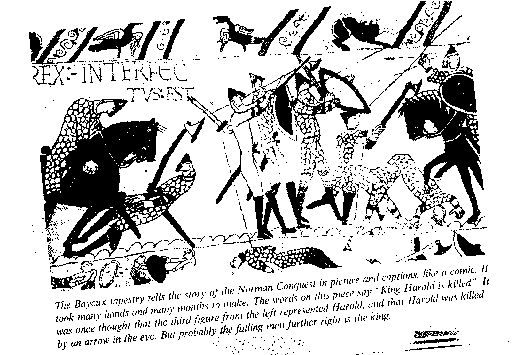
13
Alfred the Great saved England from the Danish conquest, but in the 10th– 11th centuries the Danes
managed to expand their possesion in Great Britain and from 1013 to 1042 the Danish royal power triumphed
in England. King al power triumphed in England. King Canut's empire included Norway, Denmark and
England. In 1042 the house of Wessex was restored to power in England, when Edward the Confessor was
elected king by the Witan. He was half-Norman, had spent his exile in Normandy, and Wiffiam the Duke of
Normandy was his cousin and a close friend.
Edward the Confessor was a religious monarch and devoted his attention to the construction of churches and
most of all to the building of Westminster Abbey.
Edward the Confessor died in 1066 without an obvious heir. And the Witan elected Harold, a Saxon
nobleman from the family of the Godwine, the king of England. Harold's right to the English throne was
challenged by William the Duke of Normandy who claimed the English Kingdom as his rightfull inherit ance
which had been alledgedly promised to him by the late King Edward the Confessor.
1066 was a crucial year for the Saxon King, and for the history of the English.
Harold had to fight against two enemies at the same time. In the South William of Normandy was preparing
to land in England, in the North, in Yorkshire, the Danes renewed their attacks against England.
Harold succeded in defeating the Danes and rushed his armies back to the South to meet William who had
landed near Hastings. His men were tired, though they had done so well in the battle against the Danish vikings.
William's army was better armed, better organized and he had cavalry.
Had Harold waited and given his army a rest, the outcome of the battle might have been different.
But after a hard and long struggle Harold and his brothers were killed in the battle of Hastings and the
flower of Saxon nobility lay dead together with them on the battle field.
The Bayeux Tapestry (231 feet long 19 inches wide) tells a complete story of the Norman Conquest of
Saxon England in over seventy scenes. In one of the scenes the Latin writing says "Harold the King is dead",
and under the inscription stands a man with an arrow in his eye believed to be King Harold.
William captured London and was crowned King of England in Westmister Abbey on Christmas Day, 1066.
The Norman period in English history had begun.
Some historians argue concerning possible ways of English history, had the Anglo-Saxons defeated William.
But History doesn't rely on the Conditional Mood.
All the invasions, raids and conquests were contributing new and new waves of peoples to be integrated into
a newly appearing nation of the English, to understand which we must know its historical roots, studying
historical facts.
Questions:

